Jacqueline Cochran
Jacqueline Cochran may not be as widely known as her friend and compatriot Amelia Earhart [1897-1937] but her achievements as a record-setting aviatrix make her worthy of equal attention. Cochran got her pilot’s license in 1932 and, at the time of her death, she held more speed, altitude, and distance records than any other pilot – male or female – in aviation history. However, this is an account of Cochran’s beauty business, how she got into it, and the history of her company, not her career as an aviatrix.
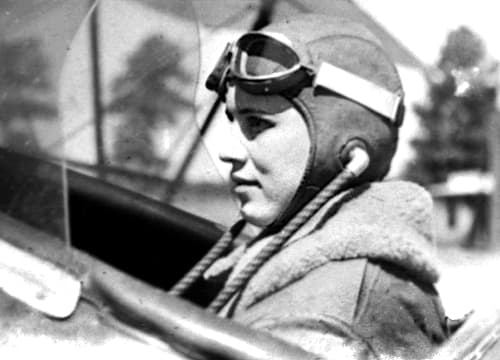
Above: 1933 Jacqueline Cochran soon after she had learnt to fly.
The history of Cochran’s life leading up to the establishment of her beauty company is patchy, and is muddied by fabrications – large and small – started by her and then repeated in numerous accounts of her early upbringing. These fictions included that she was adopted, grew up in a family that was desperately poor, and then later reinvented herself under a new name selected from the phone book. These tales call into question Cochran’s other recollections, including her accounts that she was employed as a beautician in her teenage years and her later engagement in the prestigious Antoine salon in New York.
Records show that Jacqueline Cochran was born Bessie Lee Pitman in 1906. Rather than being adopted, as she claimed, she was the youngest of five children born to Ira Pittman [1866-1928] and Mary Ann Pitman, née Grant [1871-1948]. The family was poor but not impoverished. Her father worked in sawmills and the family moved around as he looked for work. They were registered in Pine Barren, Florida in the 1910 census but were in Paxton, Florida according to the 1920 census, at which time Bessie was the only child still at home.
In 1920, aged 14, Bessie met Robert H. Cochran [1867-1944] who was more than double her age. When Bessie got pregnant the couple married and, soon after, in early 1921, Bessie Pitman, now Bessie Cochran, gave birth to a son, Robert Cochran Junior. In 1925, the four-year-old Robert Cochran died from burns he received after playing with matches. After this, the shaky marriage dissolved and divorced followed in 1927.
In 1929, Bessie Cochran moved to New York where she lived as Jacqueline Cochran, the surname coming from her marriage not the phone book. According to the account of her life she published in LIFE in 1954, she found lodgings in New York in a room near Broadway and 79th Street and worked in the Antoine de Paris salon in Saks Fifth Avenue, a job she claims to have got through her previous experience working in beauty salons.
Also see: Antoine
In the LIFE article, Cochran says that she first started working in beauty shops when she was about 11 during a strike at the Columbus cotton mill where she had been employed.
Mrs. Ryckeley was a small dark women. She said she would give me a job and so I went to live with the Ryckeleys and their seven sons. … Every day I was up at 5 o’clock and helped with the breakfast and the cleaning up. Then I would go off to work at one of Mrs. Ryckeley’s three beauty shops, cleaning the booths and making up big batches of shampoo and henna for the day. In a back room only lit by a gas jet I was taught to make transformations (wigs). Soon I started giving shampoos and helping to give permanent waves.
(Cochran, 1954, pp. 101-102)
She then writes that, aged 14, she moved to Montgomery and began working in a beauty salon there, taking lodgings in a house at 12 South Ann Street.
One day I heard a salesman for a beauty equipment company telling Mrs. Ryckeley that a certain store in Montgomery, Ala. would buy a permanent wave machine if only it could get an expert operator. I walked into the room and said I was an expert operator. At 14, I left Columbus for Montgomery and went to work there.
(Cochran, 1954, p. 102)
While in Montgomery, she claims to have studied nursing for three years before taking a job with a doctor in Bonifay, Florida. However, as the pay was low, she returned to better-paid, beauty-parlor work before heading to New York.
I determined that, if I was going to do anything for myself and others, I had to get away and make money. I went back to beauty-parlor work, first in Pensacola, then in Biloxi and Philadelphia, and soon I thought I was ready for the biggest city of all. I sold my car and set off for New York.
(Cochran, 1954, p. 104)
These recollections are at somewhat at odds with available records. The 1920 census, as previously noted, has her living with her parents in Paxton when she was 14, not Columbus, and when her son Robert Cochran died in 1925, she was married and living in DeFuniak Springs, not single and living in Montgomery.
Her claim to have worked for Antoine in New York is also questionable. The 1930 census has a Jacqueline Cochran, unemployed, aged 24, born in Florida, lodging at 707 West 171st Street, New York not near Broadway and 79th Street. Also at the same address, and directly above the listing for Jacqueline Cochran, is a Charles Cochran, restaurant proprietor, aged 30, born in France, arriving in the United States in 1925. Both Jacqueline Cochran and Charles Cochran claim in the census that their ‘Age at first marriage’ was the same, namely 1925. Of course this may just be a coincidence.
It also note that, as far as I can tell, Cochran only began mentioning her experience in salons and her time with Antoine in New York after she founded her beauty business. In at least one newspaper report before then she seems to have described herself as a New York model, not a New York beautician.
The Roosevelt Flying School welcomed its newest feminine fledgling to its ranks several days ago. She is Miss Jacqueline Cochran, 25, a New York model, who signed up for a private pilot’s course, including ground school instruction. A half-hour after her arrival at the field she was up in the air with “Husky” Flewellin for her first lesson, and to date has had three hours of dual instruction. She revealed she had made a wager with a friend who sailed for Europe last week that she would have her private license with-in three weeks’ time. She is planning a cross-country flight to her home In Florida upon completion of her flying course.
(Brooklyn Daily Eagle, New York, Wednesday, July 27, 1932, p. 13)
Although it does not rule out the possibility that Cochran had worked as a beautician before 1935, this suggests that she may have concocted these stories to give her business credibility.
Moving to firmer ground, Jacqueline Cochran writes that she first met Floyd Bostwick Odlum – one of the richest men in America at the time – in Florida, in 1932. A relationship developed but Odlum was married so the couple saw each other in secret. They married in 1936 after Odlum got divorced from Hortense McQuarrie Odlum [1891-1970] in 1935. Odlum’s money would helped establish Cochran’s career as an aviatrix and her beauty business.
Wings to Beauty
Jacqueline Cochran’s documented beginnings in the beauty business start with the establishment of the J. C. Laboratories at 1203 Chandler Avenue, Roselle, New Jersey and Jacqueline Cochran Salons in Chicago, Illinois, in 1935. In 1936, she then opened three Jacqueline salons situated at 700 North Michigan Avenue, Chicago; Deerpath Inn, Lake Forest, Illinois; and the Ambassador Hotel, Los Angeles; the Deerpath Inn salon closing by 1941. The salons look to have concentrated on permanent waving, a beauty treatment that did well through the years of the Great Depression.
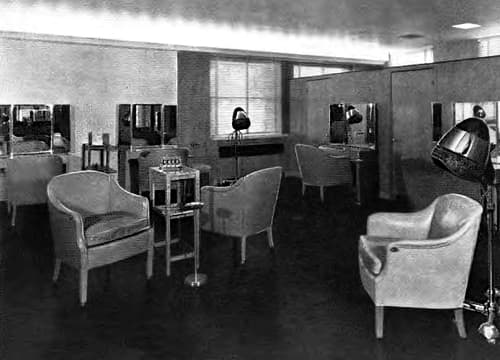
Above: 1936 Jacqueline Cochran Beauty Salon with facilities for hair dressing and permanent waves, manicures and possibly make-up. “[A] salon of true continental charm, where men of international prestige sculpture coiffures of smart personalized individuality – and where Miss Cochran’s exceptional ‘Wings to Beauty’ cosmetics and treatments are available.”
There are suggestions that Cochran was selling some Wings to Beauty cosmetics by 1936 but the full range only appears to have become available in 1937. They were packaged in soft, grey containers with white lids designed by Adam Baker Barnhart [1911-1965] of Richard Lowry Associates. The cosmetics were developed through J. C. Laboratories in Roselle – moved to 42 Miller Street Newark in 1939 – and there are photographs of Cochran in a laboratory giving the impression that she was involved in their creation.
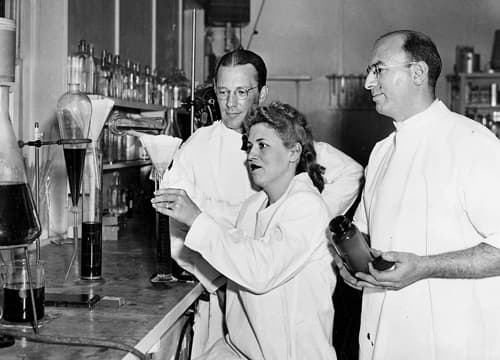
Above: Jacqueline Cochran in the laboratory (Eisenhower Presidential Library).
The 1937 Wings to Beauty range included a Cleanser, Night Cream for dry skin, Night Cream Blend for average skin, Pore Texture Cream for oily skin, Eye Cream, Throat Cream, Film Masque, Foundation, Face Powder, Mascara, Rouge, and Lipstick. By 1938, the range was available through the following department stores: B. Altman, New York; Julius Garfinkel, Washington; M. O’Neil, Akron; B. Forman, Rochester; Hall Brothers, Cleveland; and H. & S. Pogue, Cincinnati but not Bonwitt Teller where Oldum’s divorced wife was the company president. Other department stores, such as I. Magnin, were added later.
In 1940, the expanding business required a move from 420 Lexington Avenue, where she had been for a year and one-half to the International Building in the Rockefeller Center.
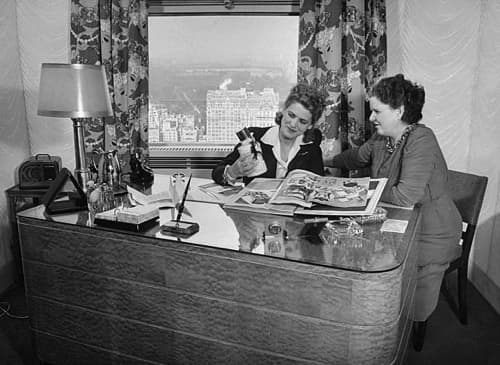
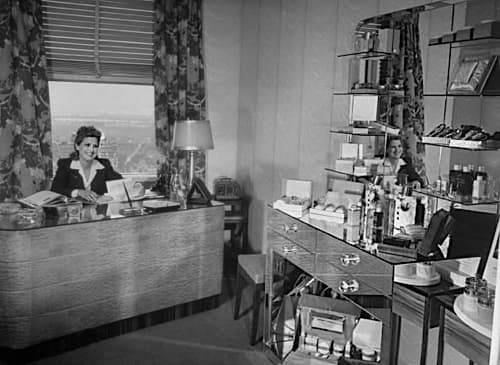
Above: 1941 Jacqueline Cochran office in the Rockefeller Center (LIFE)
Later pre-war additions to the range included Take-Off (1940), a depilatory and Foundation Tint (1941).
Foundation Tint: “[B]lemish concealing foundation lotion especially formulated to give a dull, velvet-smooth finish to oily skins.” Shades: Natural, Rose, Rachelle, Ecru, and Rosy Suntan.
Cochran also introduced a number of perfumes including Jacologne (1939), Pursuit (1941), Merry-Go-Round (1941), and Shining Hour (1941). These were also used to fragrance a number of cosmetics including products for the bath.
After the launch, new shades were added to the Wings to Beauty make-up range. New lipstick shades included: Fuschia, and Firecracker (1939); and Sizzling Red, Razzle Dazzle, Carnelian, and Captain’s Choice (1940). In 1940, Cochran also launched five coordinated Fur-Tone make-up shades blended to compliment different furs. Each box of Fur-Tone contained a foundation, face powder, cream rouge, lipstick, eyeshadow, and mascara along with a bottle of Jacologne. Shades: Tawny for lynx, leopard, and ocelot furs; Sleek for sealskin, Persian lamb, broadtail, and caracul furs; Angel for chinchilla, platina fox, and krimmer-grey furs; Mink for brown furs; and Puff for white furs.
Chromablend
In September, 1940, Jacqueline Cochran debuted Chromablend, a foundation cream that women could have blended on the spot in a shade personalised to their individual colouring. It used an idea similar to that employed by Charles of the Ritz and others to make individually blended face powders. It underwent a number of changes before being discontinued after the Second World War.
Chromablend: “[I]ndividually blended for you from deeply tinted creams of the Jacqueline Cochran color wheel . . . making a perfect color foundation for your individual complexion . . . while you wait and watch.”
The Chromablend foundation cream was mixed up using a combination of seven tones behind a lucite case. As there are seven notes in a scale and this might explain the ‘musical’ theme to the original Chromablend logo.
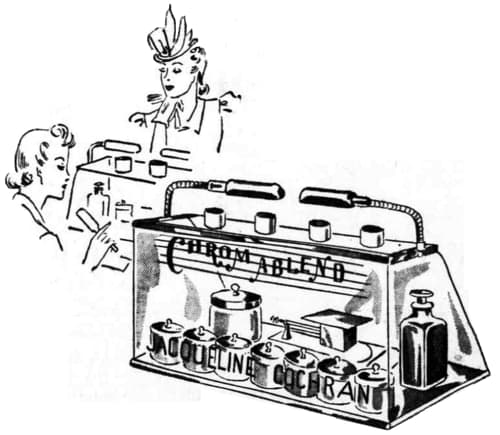
Above: 1940 Jacqueline Cochran Chromablend.
After the launch, the lucite case was quickly replaced by a more open arrangement.
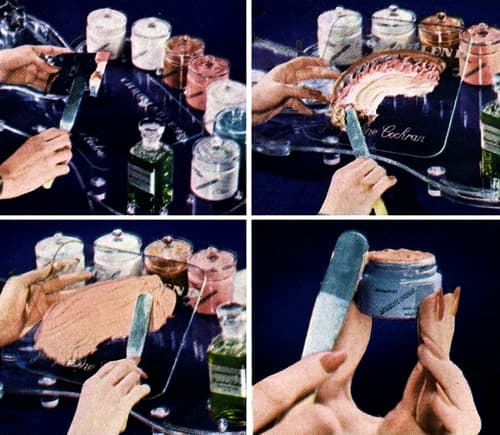
Above: 1946 Chromablend foundation mixed up on a lucite platter.
In 1948, continuing the translucent idea, Jacqueline Cochran introduced a seashell container to hold Chromablend.
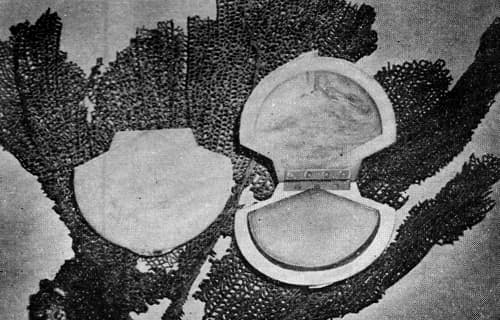
Above: 1948 Translucent seashell container.
By 1943, Jacqueline Cochran Make-Up Bars had added Powderblend – individually blended face powders – to Chromablend and, by 1950, Chromablend appears to have been dispensed with altogether in preference to a Jacqueline Cochran Powder Blending Service which mixed up face powders using an arrangement very similar to that from Charles of the Ritz or Antoine de Paris.
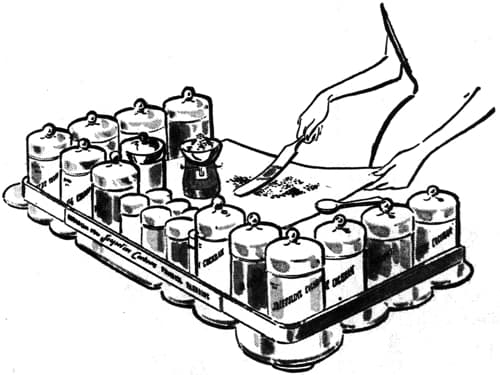
Above: 1951 Jacqueline Cochran Powder Blending.
See also: Charles of the Ritz Powder Bars.
Packaging
Like other cosmetic companies, Cochran produced a range of travelling kits. As an aviatrix, she was very interested in light, compact, spill-proof packaging that she could take with her on a plane. This led her to introduce a little 3½ tube – in Ivory, Red or Blue – containing five beauty aids. Widely promoted after the Second World War as the Perk-Up Stick, the product had its origins in 1937. It would appear to have been one of many versions of a plastic make-up kit invented by Benjamin Franklin Conner [1884-1963] (US:2077219, 1937) assigned to, and manufactured by, Colt Plastics, a division of the Colt’s Patent Fire Arms Manufacturing Company.
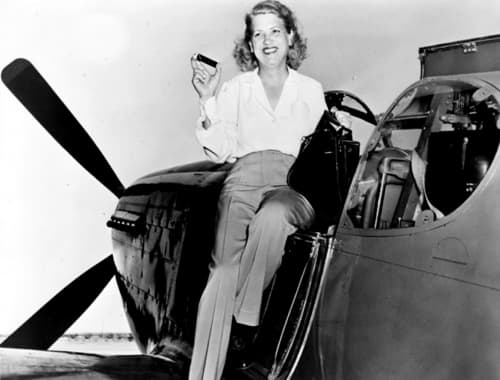
Above: Jacqueline Cochran holding a Perk-Up Stick.
Cochran extended this click-together idea to larger-sized jars of Night Creams, Cleansing Creams and Powder. In 1939, these were used to create a double-decker container in her Week-End Kit, and the triple-decker container in her Deb Kit. Unfortunately, I have no record of what Cochran called the original little 3½ tube, but I note that Cochran claims to have first used the name Perk-Up in 1941.
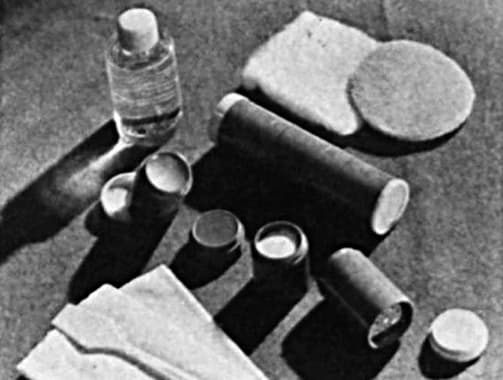
Above: 1939 Early version of Perk-Up.
War
Jacqueline Cochran was heavily involved as a pilot during the Second World War and this may partly explain why there were few developments in her cosmetics range in this period. The only new product, that I know of, was a stocking replacement, a common cosmetic of the period.
Jacqueline Cochran Leg Make-Up: “[D]ries quickly . . . won’t smear . . . stays on like the sheer magic or is . . . slimming, trimming your legs to suntanned beauty.” Shades: Beige, and Suntan.
See also: Cosmetic Stockings
Post-war
After the war, Jacqueline Cochran went on a buying spree starting with the purchase of the Edey Mansion on 10 West 56th Street, New York in 1945. The following year, the company began selling Endocreme, a hormone skin cream introduced into the American market in 1937.
See also: Hirestra Laboratories (Endocreme)
In 1949, Cochran acquired the United States distribution rights to Nina Ricci perfumes, first sold into the American market in 1947. This was the start of a number of fragrance additions which would alter the course of the company.
Other products added by Cochran through into the 1950s included: a new deodorant – Lotion Deodorant (1947); cleansers – Super Cleanser (1948) and Lotion Quick Cleanser (1953); Hand and Arm Cream (1953); – Flowing Velvet (1949); foundations – Radiant Glo (1950) and Derma Sheen (1953); and a mascara – Cream Mascara (1954).
Lotion Deodorant: “It gives you double protection against underarm odor because it’s both a deodorant and anti-perspirant. Stops odor and checks perspiration.”
Super Cleanser: “Have you a skin troubled by blemishes or coarseness? … Just apply as you would cleansing cream, rub into a lather, remove with a damp cloth for an immaculate, clear-looking complexion.”
Lotion Quick Cleanser: “[A] refreshing-as-a Springtime rain quick cleanser that leave skin radiantly clean, cool, facial fresh.”
Hand and Arm Cream: “A superlative cream that effectively combats chapping roughness, dry-skin wrinkles, crepiness. Here finally, is a cream that helps replenish nature’s own requirements for softness and beauty—a cream that pampers your hands and elbows as you pamper your face.”
Flowing Velvet Lotion: “[W]ith exclusive Hydrolin, gives your skin what young skin gets from nature—oils and moisture—and plenty of both. Tiny lines seem to smooth out; dry, flaky skin vanishes. Make-up glides on like a dream.”
Radiant Glo: “[A] flattering greaseless foundation, will not fade, streak or shine. Conceals tiny complexion faults, holds your make-up all day.” Shades: Sandy Beige, Natural, Rose Beige, Rose Rachel, Apricot Tan, and Suntan.
Derma Sheen: “[C]ontains gentle lubricants for moisture-giving protection, will not stiffen or age a dry, delicate or mature skin. Derma Sheen flows a dewy bloom for flawless young color over your skin, in an exquisite sheer sheen so fine you cannot feel it.” Shades: Sandy Beige, Natural, Rose Bronze, Rose Rachel, Apricot, and Suntan.
Of these, Flowing Velvet was the most important. This greaseless, yellow-tinted lotion formulated with moisture-giving Hydrolin was an early example of a skin-care cosmetic that stressed moisturisation.
Flowing Velvet
Following the success of Flowing Velvet, Cochran extended the concept into other skin-care and make-up products creating the Flowing Velvet Treatment and Make-up Series. The range included Flowing Velvet Super-Rich Cream (1958), Flowing Velvet Make-up (1958), Flowing Velvet Joy of Bathing (1959), Flowing Velvet Eye Cream (1959), Flowing Velvet Lipstick (1959), Flowing Velvet Pressed Powder (1959), and Flowing Velvet Radiant Masque (1960).
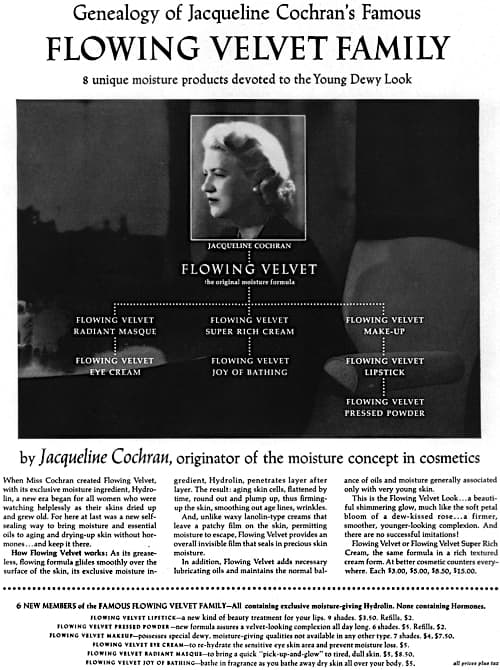
Above: 1960 Flowing Velvet Family.
Flowing Velvet Eye Cream: “Keep the soft dewy look of a young complexion with greaseless Flowing Velvet, a unique discovery that penetrates to sub-surface tissues where aging starts.”
Flowing Velvet Super-Rich Cream: “[W]ith exclusive Hydrolin plus Royal Jelly. The most potent aid for dry skin! Flows moisture, transmits proteins, vitamins, nutritive elements into your skin. Greaseless but still maintains normal oil-and-moisture balance!”
Flowing Velvet Make-Up: “[W]ith moisture-giving Hydrolyn . . . flatters your complexion to perfection with a Flowing Velvet finish rather like the velvety petal bloom of a naturally lovely, very young skin.” Shades: Petal Beige, Radiant Rachel, Luscious Peach, Dewy Rose, and Sun Glow.
Flowing Velvet Joy of Bathing: “[A] new and luxurious idea for the bath, containing Miss Cochran’s exclusive moisture ingredient Hydrolin. Specially formulated and perfumed for all-over smoother, softer, delicately-scented skin. Bathe in fragrance as you bathe away dry skin.”
Flowing Velvet Lipstick: “[A]ctually a new lipstick treatment containing Hydrolin . . . helps add moisture to the lips. The result is a softer, dewier finish . . . younger looking, more alluring. A must for all women with dry or sensitive lips.” Nine shades along with White Glitter, a pearlescent overlay.
Flowing Velvet Radiant Masque: “It’s a real cocktail for your skin, giving a fresh, dewy, smooth bloom and radiance.”
Flowing Velvet Pressed Powder: “A creamy pressed powder that spreads like a dream, that assures you of a flawless, glowing velvet-looking complexion all day long without retouching.” Shades: Natural Blush, Star Dust, Bright Rachel, Sun Bronze and Suntan.
The Super-Rich Cream was originally formulated with Royal Jelly, a common additive in the 1950s, but this seems to have been removed after 1960.
See also: Royal Jelly
Additions to the Flowing Velvet range in the 1960s up to when the company was sold to Shulton included: Flowing Velvet Soap (1964); and Flowing Velvet All Over Velvet (1965).
Flowing Velvet All Over Velvet: “[F]or use over the entire body. It moisturizes and gives the skin a more youthful texture.”
Lipsticks
Information on Jacqueline Cochran lipsticks released after the war is very sparse. The vogue in indelibles started by the release of Hazel Bishop’s Lasting Lipstick in 1950 led Cochran to refer to its lipsticks as Color Cling in 1951. New shades were also released in the early 1950s, those that I know of being Torch Red (1950), Perk-up Red (1951), PinkTang (1951), Bandwagon Red (1952), Firecracker Red (1954), Orange Poppy (1954). The move to creamier lipsticks later in the decade also saw Cochran add Flowing Velvet Lipsticks (1959) in refillable, click-in, hand-brocaded, silver-plated cases. By 1959, the company had also added a number of fashionable pink lipsticks shades – Pink Azalea, Cupid’s Pink, Pink Tang, Pursuit Pink, and Pink Dawn. Other colors in the range included Coral Bell, Rose, Bud Red and Fire Pink.
See also: Lipstick Wars
Clear Complexion Kit
In 1955, Jacqueline Cochran introduced the Clear Complexion Kit aimed at the youth market. The kit consisting of three medicated preparations to banish pimples, blackheads and acne from skin and scalp. Unfortunately, I do not know the medication used in each. The Clear Complexion Lotion could be used by itself or employed as a foundation with the Neutral shade suggested for boys with skin problems.
Clear Complexion Soap: “[H]elps to rid clogged pores of dirt, hardened oils and stale makeup. It contains ingredients which combat surface bacteria and blackheads.”
Clear Complexion Shampoo: “[C]orrects the scalp condition which accompanies troubled skin. Also, it eliminates oil! ness and dandruff.”
Clear Complexion Lotion: “[S]oothes and helps heal as it conceals blemishes. Combats bacteria and excess oil while it acts as a light foundation.” Shades: Star Dust, Rose Rachel and Neutral.
Cochran suggested that some of its older products, such as the Pore Texture Cream or Super Cleanser, might also prove useful on problem skins.
Image of Youth
Elizabeth Arden’s Crème Extrordinaire (1958), and Revlon’s Ultima (1959) both came in elaborate jars designed to emphasise the importance of their contents. In 1961, Cochran released the Image of Youth Nutrient Cream with Generin also in an ornate jar.
Image of Youth Nutrient Cream: “[T]he phenomenal nutrient cream, that stirs up the Youth impulse in your skin.”
The Nutrient Cream was to be used in conjunction with other Image of Youth cosmetics in a treatment regime consisting of Image of Youth Stimulating Rays Lotion, Image of Youth Preparation B-1 Lotion for Normal or Oily skin, and Image of Youth Preparation B-2 Lotion for Dry or Sensitive Skin.
This unique “Image of Youth” acts on an entirely new principle . . . gently, it encourages the under-skin cells, below the surface, to multiply as they did in youth. Soft, plump, new cells tend to fill in wrinkles and hollows . . . day by day, these lines tend to round out. The key ingredients that start this chain of reactions have never been used in cosmetics, this way before. If you make this treatment your nightly beauty ritual, you can hope for an “Image of Youth” for many more years. Please note these facts: 1—Cleanse first with Jacqueline Cochran’s Stimulating Ray Lotion, 2—Follow with Preparation B-1 for normal or oily skin or Preparation B-2 for dry or delicate skin, 3—Then bless your skin with “Image of Youth” Nutrient Cream.
(Jacquelin Cochran advertisement, 1962)
The range does not appear to have garnered a good following and the company continued to promote its better selling Flowing Velvet.
Later developments
In 1965, Jacqueline Cochran was sold to Shulton, best known for Old Spice. Shulton’s toiletries, cosmetics and fragrances were primarily distributed through drug store chains and mass-volume retailers whereas the fragrances and cosmetics made and/or distributed by Jacqueline Cochran were sold principally in department stores so the purchase gave Shulton access to a more upmarket clientele. After Shulton secured Carven French Perfumes and Pierre Cardin perfumes and toiletries, in 1966 and 1967 respectively, these were added to Jacqueline Cochran.
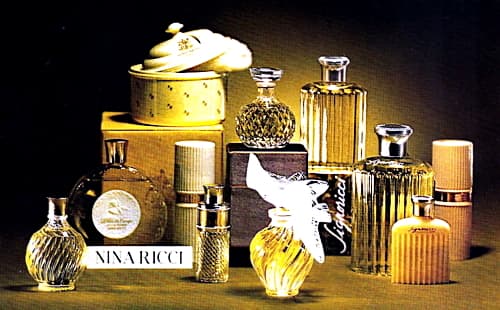
Above: 1968 Nina Ricci.
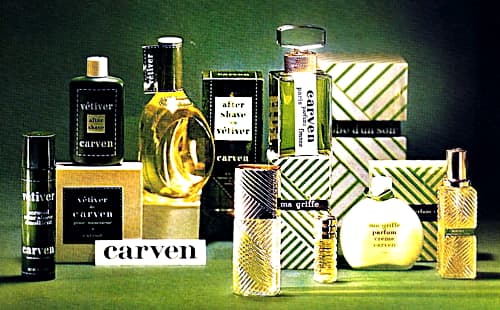
Above: 1968 Carven.
Shulton extended the Jacqueline Cochran cosmetics range adding Flowing Velvet Seven Layer Cleanser, Flowing Velvet Creme Opaline Make-up, Flowing Velvet Cake Eyecolor, Flowing Velvet Whipped Cream Color, Flowing Velvet Super-Richstick, and Flowing Velvet Model Mouth but its hopes for line proved to be illusory. In 1969, following poor sales of its Urbane Collection, Shulton abandoned most Jacqueline Cochran cosmetics leaving only the two best sellers remaining – Flowing Velvet Hydrophilic Lotion, and Super-Rich Night Cream. These too, also disappeared sometime after Shulton was bought by American Cyanamid in 1971.
See also: Shulton
In 1978, American Cyanamid consolidated Jacqueline Cochran, Inc. with Shulton’s other group of perfumes, the Contemporary Fragrance Group established in 1977. This added Cie and Tabac to products by Jacqueline Cochran, Nina Ricci, Pierre Cardin and Carven fragrances.
In 1980, following American Cyanamid’s purchase of Geoffrey Beene, Inc. and its subsidiary, Epocha Distributors, Inc., Jacqueline Cochran gained responsibility for a number of men’s colognes including Grey Flannel. When Sanofi, Inc. bought Jacqueline Cochran from American Cyanamid in 1987 they were therefore mostly buying a fragrance rather than a skin-care and make-up company. I do not know what happened to Jacqueline Cochran, Inc. after the sale but currently it appears to be defunct.
Timeline
| 1935 | J. C. Laboratories and Jacqueline Cochran Salons established. |
| 1936 | Salons opened in Chicago, Lake Forest, and Los Angeles. |
| 1937 | New Products: Wings to Beauty range launched. |
| 1939 | Manufacturing moved to 42 Miller Street, Newark. |
| 1940 | Offices moved to 630 Fifth Avenue, New York. New Products: Chromablend; and Take-Off, a depilatory. |
| 1945 | Edey Mansion at 10 West 56th Street, New York purchased for new headquarters. |
| 1946 | The rights to Endocreme purchased. New Products: Perk-up Stick. |
| 1947 | Company incorporates as Jacqueline Cochran, Inc. New Products: Lotion Deodorant. |
| 1949 | Acquires the American distribution rights to Nina Ricci perfumes. New Products: Flowing Velvet Lotion. |
| 1950 | Buys Parfums Charbert. New Products: Radiant Glo. |
| 1953 | New Products: Lotion Quick Cleanser; Hand and Arm Cream; and Derma Sheen. |
| 1954 | New Products: Cream Mascara; and Sun ’n Sand foam sun-screen. |
| 1958 | New Products: Flowing Velvet Super-Rich Cream; and Flowing Velvet Make-up. |
| 1959 | New Products: Flowing Velvet Joy of Bathing; Flowing Velvet Eye Cream; Flowing Velvet Pressed Powder; and Flowing Velvet Lipstick. |
| 1960 | New Products: Flowing Velvet Radiant Masque; and Satin Foam cream soap. |
| 1963 | Allen B. Wrisley Company (soaps and toiletries) bought from Purex Industries, Inc. New Products: Lash-On. |
| 1964 | New Products: Flowing Velvet Soap. |
| 1965 | Jacqueline Cochran sold to Shulton. New Products: Flowing Velvet All Over Velvet. |
| 1966 | New Products: Flowing Velvet Creme Opaline. |
| 1968 | New plant opened in Moosic, Lackawanna County, Pennsylvania. New Products: Urbane Collection. |
| 1971 | Shulton bought by American Cyanamid. |
| 1987 | Jacqueline Cochran sold to Sanofi Beauty, Inc. |
First Posted: 20th October 2020
Last Update: 6th April 2022
Sources
Cochran, J. (1954). I reached the stars the hard way. LIFE, 37(7), 93-97.
Shulton, Inc. Annual Reports 1968-1970.
Teitel, A. S. (2020). How Bessie Pittman became famed aviatrix Jackie Cochran. Retrieved October 2, 2020, from https://medium.com/the-vintage-space/how-bessie-pittman-became-famed-aviatrix-jackie-cochran-1f627028da99
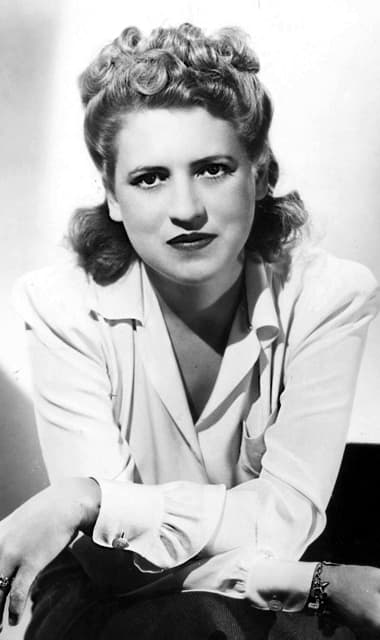
Jacqueline Cochran [1906-1980] a.k.a Bessie Lee Pitman, Bessie Lee Cochran, and Jacqueline Odlum.
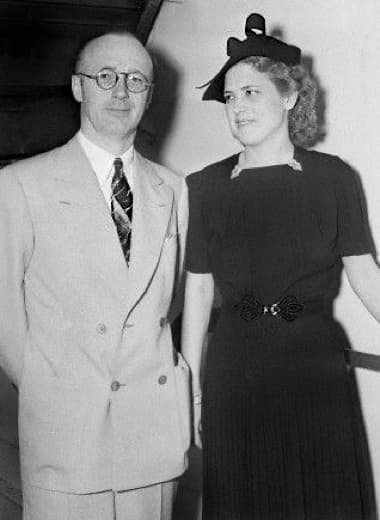
Floyd B. Odlum [1892-1976] and Jacqueline Cochran.
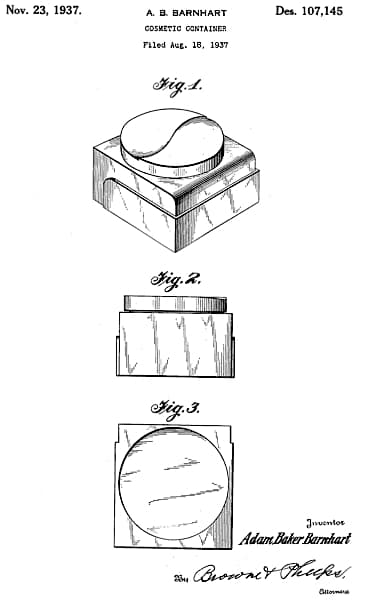
1937 Wings to Beauty container designed by Adam Baker Barnhart [1911-1965].
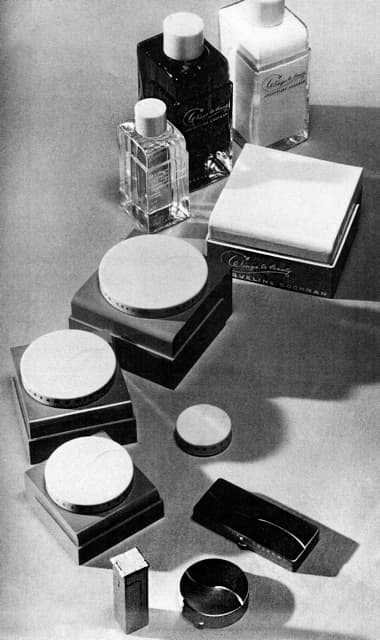
1937 Jacqueline Cochran Wings to Beauty cosmetics.
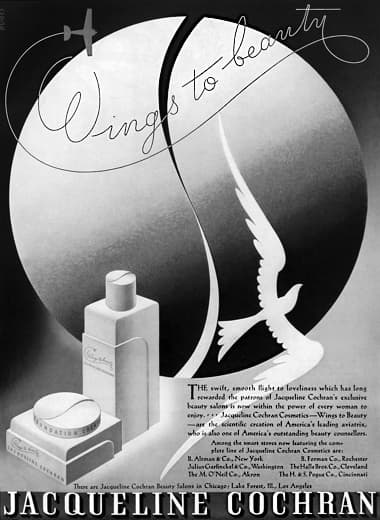
1938 Jacqueline Cochran Wings to Beauty.
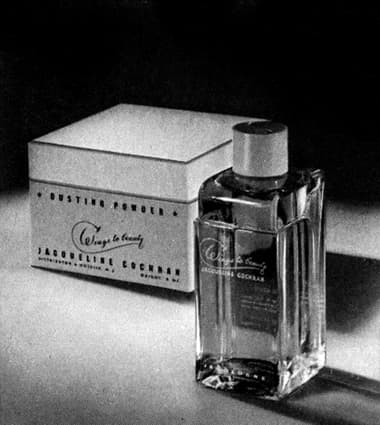
1939 Jacqueline Cochran Dusting Powder and Jacologne.
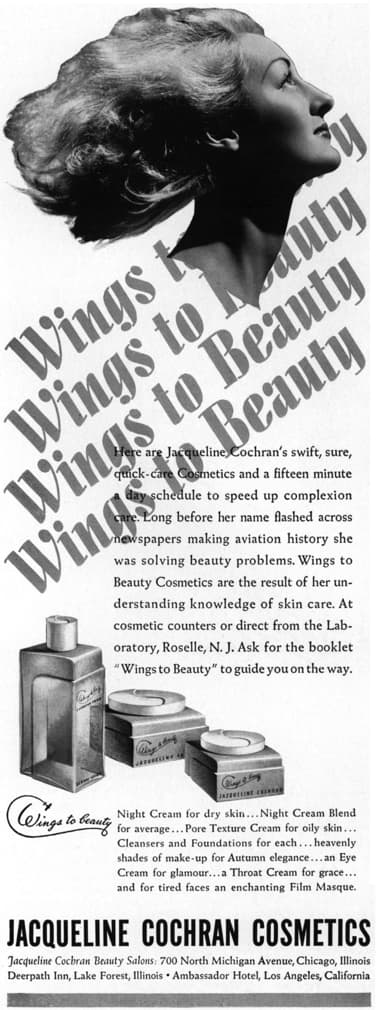
1939 Jacqueline Cochran Wings to Beauty.
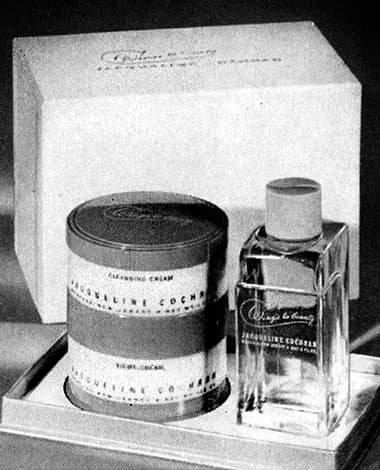
1939 Jacqueline Cochran Week-End Kit containing Cleansing Cream, Night Cream and Skin Lotion.
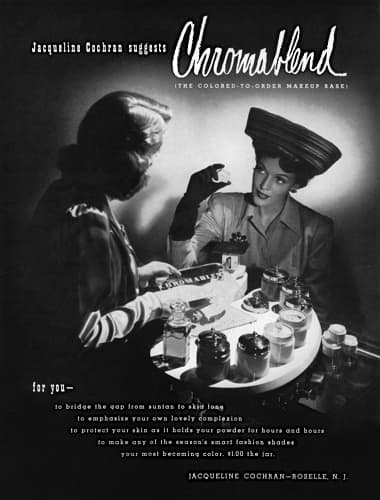
1941 Jacqueline Cochran Chromablend.
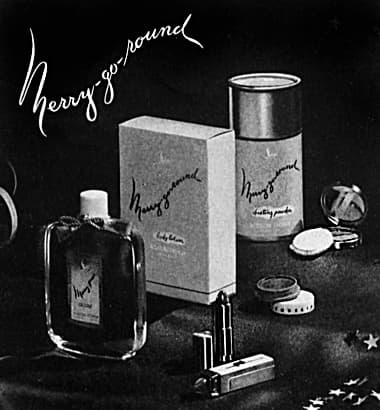
1941 Jacqueline Cochran Merry-Go-Round Cologne, Body Lotion, Dusting Powder, Lipstick, and rouge.
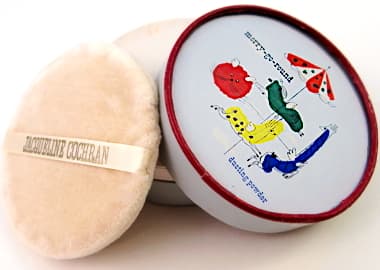
Dusting Powder box designed by Paul Rand [1914-1996].
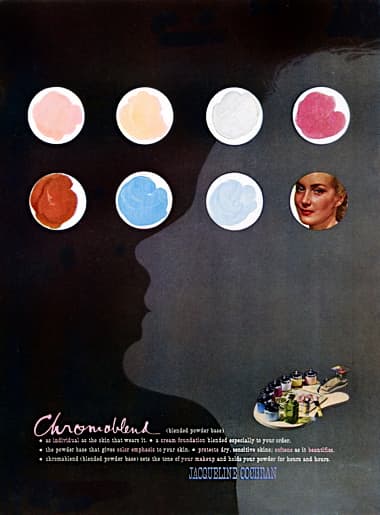
1944 Jacqueline Cochran Chromablend.
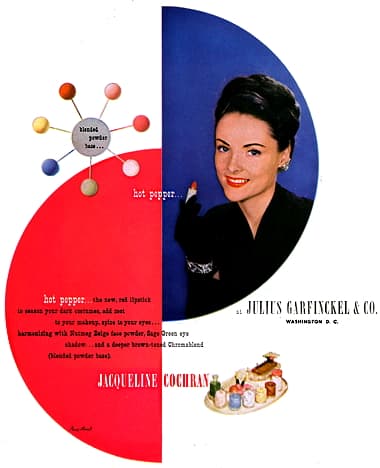
1945 Jacqueline Cochran Hot Pepper.
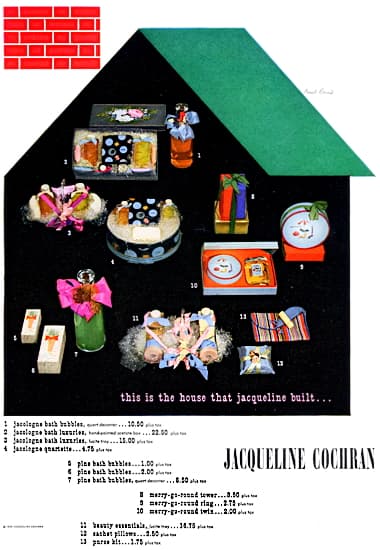
1945 Jacqueline Cochran products.
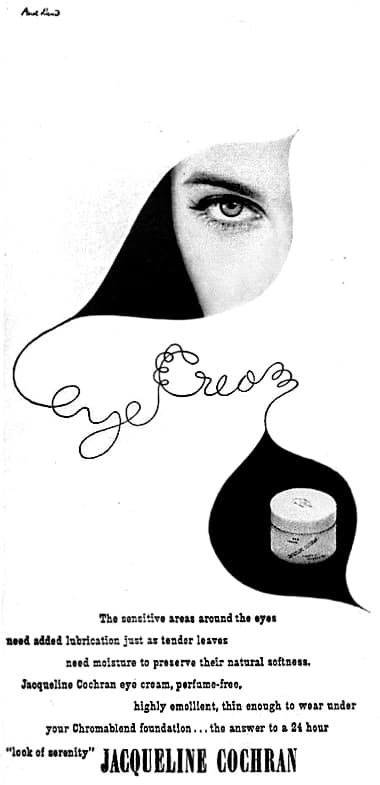
1946 Jacqueline Cochran Eye Cream.
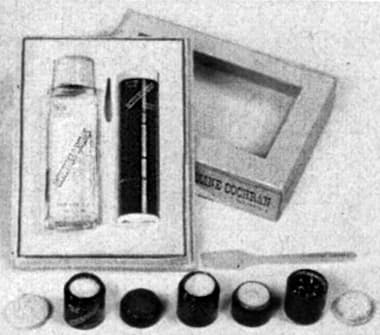
1946 Jacqueline Cochran Perk-Up Stick containing a Cleansing Cream, Night Cream, Foundation Cream, Cream Rouge, and Face Powder packaged with a bottle of Skin Lotion and a spatula.
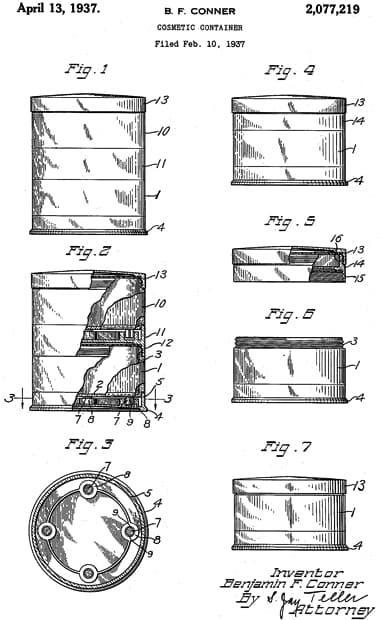
1937 Diagram from the Benjamin F. Conner patent (US:2077219) assigned to Colt Plastics.
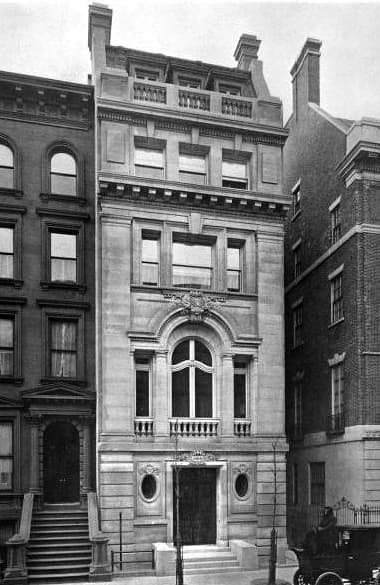
Edey Mansion as it appeared in 1903. Constructed in 1901 for Frederick C. Edey and his wife Sarah Birdsall Otis Edey. It still stands today with a ground floor that has been extensively altered.
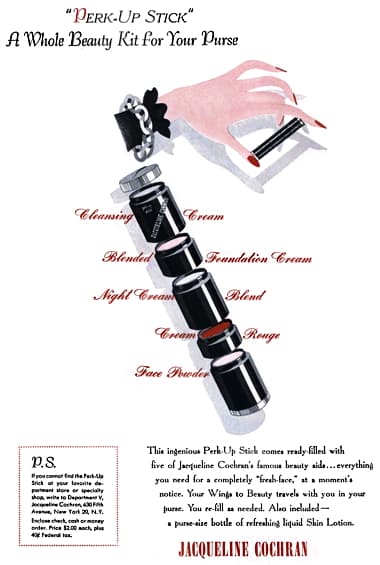
1947 Jacqueline Cochran Perk-Up Stick. It came in a choice of Ivory, Red, or Blue cases.
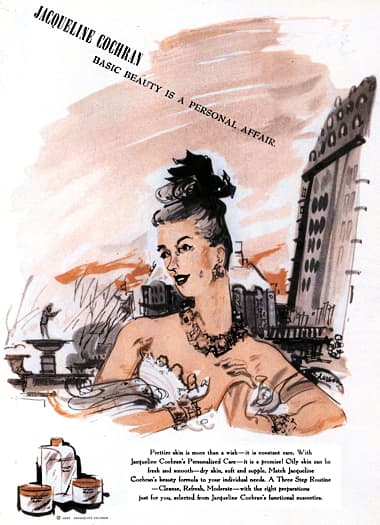
1947 Jacqueline Cochran.
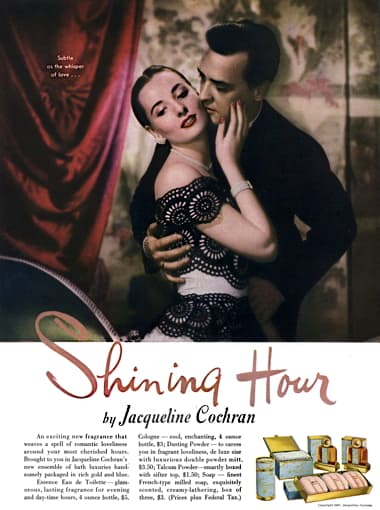
1947 Jacqueline Cochran Shining Hour.
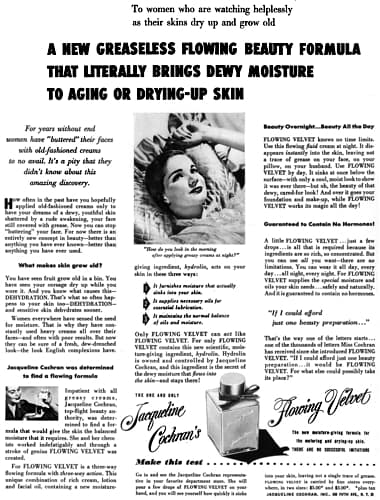
1951 Jacqueline Cochran Flowing Velvet.
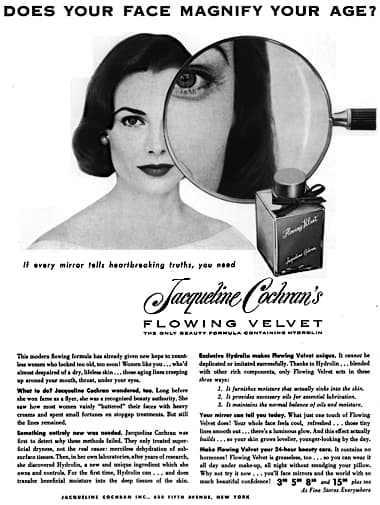
1955 Jacqueline Cochran Flowing Velvet.
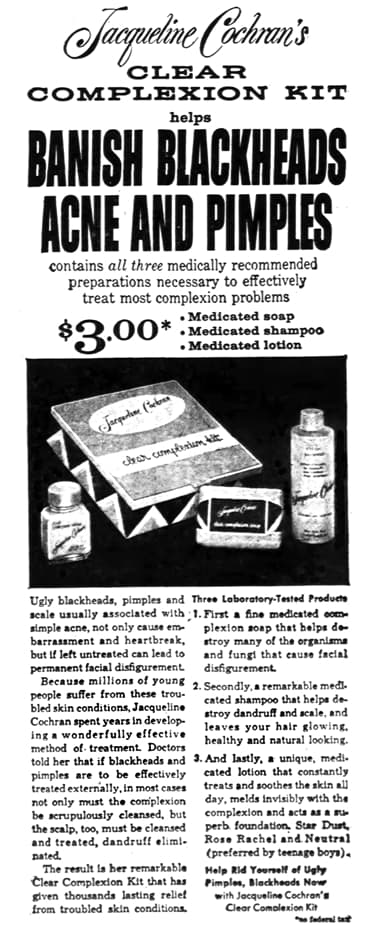
1957 Jacqueline Cochran Complexion Kit.
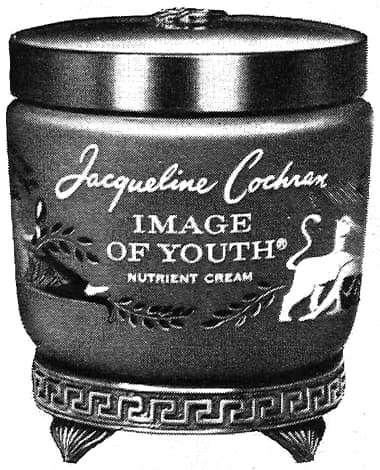
Jacqueline Cochran Image of Youth Nutrient Cream in bois de rose, urn-shaped jars with Romanesque tracery in gold and white.
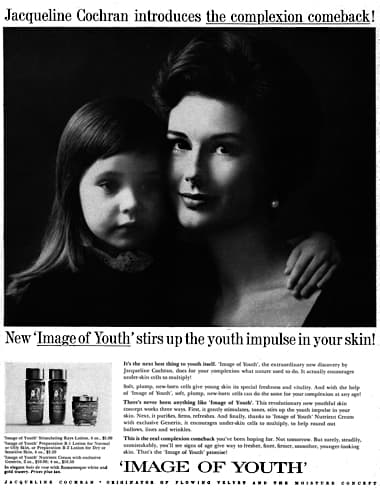
1962 Jacqueline Cochran Image of Youth range.
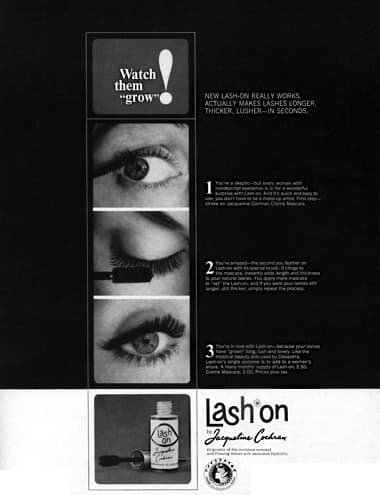
1963 Jacqueline Cochran Lash-On applied under mascara to thicken lashes.
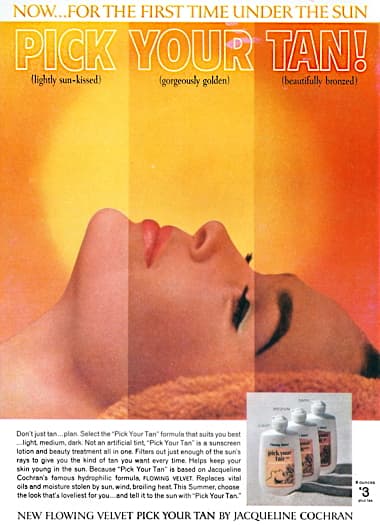
1964 Jacqueline Cochran Pick Your Tan.
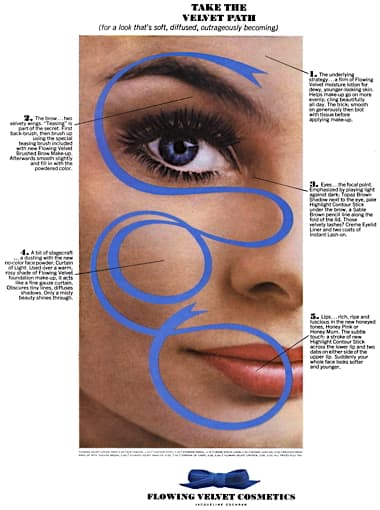
1964 Jacqueline Cochran Flowing Velvet.
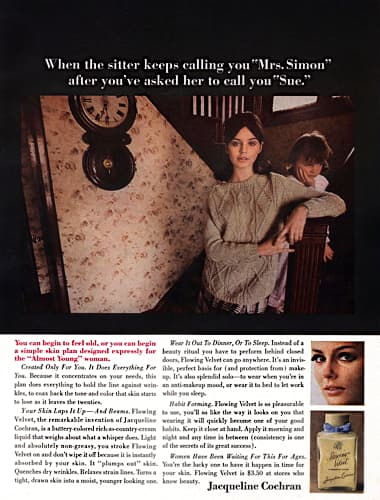
1966 Jacqueline Cochran Flowing Velvet.
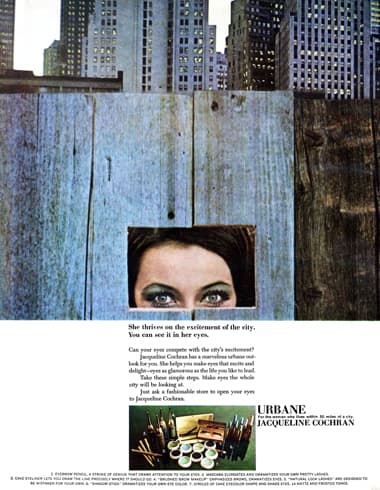
1968 Jacqueline Cochran Urbane Eye.
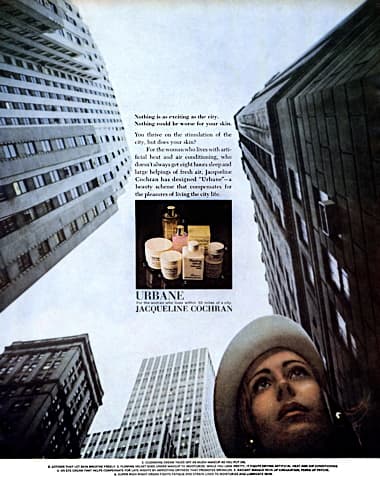
1969 Jacqueline Cochran Urbane Collection of skin-care.
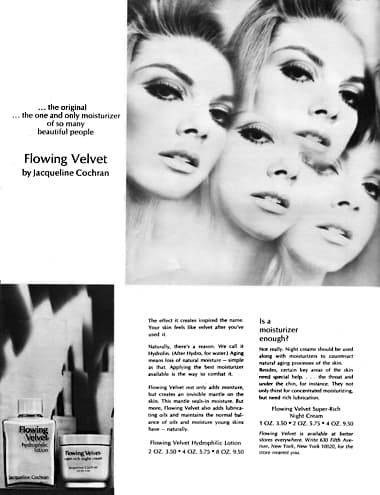
1969 Jacqueline Cochran Flowing Velvet Hydrophilic Lotion and Super-Rich Night Cream, the only remaining members of the Flowing Velvet family.
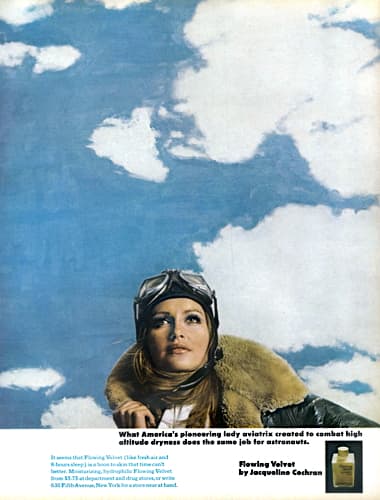
1969 Jacqueline Cochran Flowing Velvet Hydrophilic Lotion.
